Best gravel bike shoes and cyclocross shoes 2024: for when you are on and off the bike
Gravel & Cyclocross disciplines ask a lot from your shoes. So, we have tested the best shoes for durability and performance on and off the bike


Cross-country and off-road terrains place greater demands on your cycling shoes requiring them to be both comfortable and robust. Of course, you might get away with road cycling shoes or even commuter cycling shoes if you're on a bikepacking trip—but purpose-built cyclocross and gravel bike shoes will ultimately serve you best.
With time almost certainly spent running or walking with your bike, until recently, most gravel bike and cyclocross bike (CX) riders have just had to pick their way through mountain bike shoes. With an upward surge in drop-bar off-road riding, more kit designed specifically to the needs of the gravel bike rider (including gravel bike clothing) are gradually becoming available.
The best gravel bike shoes and cyclocross shoes will almost definitely feature built-up areas along the sole, constructed with softer, grippier rubber that can handle thick mud and rugged terrain. They will also likely use mountain bike-style SPD cleat systems recessed into the shoe for better mud clearing and ease of use. Many also offer the ability to add spikes/studs or greater protection from the elements.
The Cycling Weekly tech team uses and abuses dozens of cycling shoes each year, this guide features 12 of the highest-rated shoes from this testing. Stand-out performances are from the Specialized Recon and Giro Sector for their ability to work across both Gravel and Cyclocross riding. For less performance-orientated shoes check out the Fizik Tempo Beat shoes, which could work well for Bikepacking and more casual riding.
The Quick List
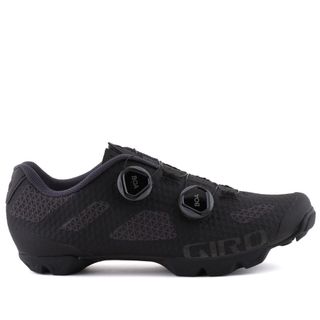
Best overall Gravel & CX shoes
We liked the weight, breathability and comfort of the Sectors. Two Boa dials allow for a precise fit and the price is very reasonable for the performance on offer. The sole does lack a little grip sometimes though.
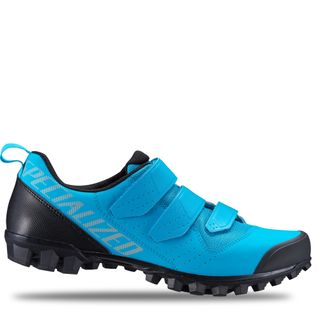
Best Gravel & CX shoes for value
The synthetic upper of the Recon 1.0 might lack a bit of ventilation, but that is rarely an issue in the UK, and the toe-flex system means that walking comfort doesn't compromise riding stiffness. The grip is good and the 3 Velcro straps allow for plenty of adjustment whilst helping to keep the price reasonable.

Best Lace-Up Gravel & CX shoes
Giro's mid-range Privateer uses a nylon midsole for pedalling power and walking flexibility, with plenty of grip on offer too. Lace closure keeps the weight down and adds some retro style whilst we were impressed by their robustness and durability.

Best Gravel & CX shoes for range of sizes
Lake offers many of its shoes in width fittings, including the MX 238 Supercross, so finding exactly the right size should be a doddle. The water-resistant leather upper and carbon sole work very well together, but they don't offer much in the way of warmth for rides that aren't flat-out at the threshold.

Best Gravel & CX shoes for narrow feet
The VR90 ticks a lot of performance boxes - a Vibram tread mated to a carbon sole unit provides grip and stiffness aplenty with toe spikes for extreme conditions. Laces add a classic aesthetic and the one-piece upper looks great, but be aware that they can come up a bit on the narrow side.

Best Gravel & CX shoes for wide feet
The wide-toe box and L6 Boa dial found on the Fizik Terra Atlas make for a comfortable and roomy shoe, versatile enough for gravel or cyclocross.
Our pick of the best Gravel and Cyclocross cycling shoes
You can trust Cycling Weekly.
Recent updates
Updated to include the new Fizik Tempo Beat and clearer categorisation
Best Overall

Giro Sectors
Specifications
Reasons to buy
Reasons to avoid
Mixing a one-piece upper and a carbon composite sole with tall side lugs, the Giro Sector shoes are thin, supple and supportive with mesh sections for good breathability. We found the sole sufficiently flexible for comfort off-bike but it still gave good pedalling support, although grip was a bit lacking for hike-a-bike in muddy conditions.
There are two Boa L6 dial closures, making for precise fit adjustment, although with the L6 you need to pop the dial to loosen, rather than having both-ways adjustability. But otherwise, the Sectors are a top choice at a reasonable price.
Read our full Giro Sector gravel bike shoes review
Best Lace-up

Giro Privateer
Specifications
Reasons to buy
Reasons to avoid
The Privateer lace-up shoe might be middle of the range from Giro, but it's certainly a great performer. Although a huge slice cheaper than Giro's flagship Empire VR90, these shoes certainly don't compromise on comfort or durability. They weigh in at 355g (size 42) per shoe.
The nylon sole gave us a good level of stiffness for pedalling but enough give for when we had to do a bit of hike-a-bike as well. The rubber-lugged outsole gives ample grip, no matter what kind of surface you're scrambling over.
Read our full Giro Privateer lace shoes review
Best value

Specialized Recon 1.0
Specifications
Reasons to buy
Reasons to avoid
The S-Works version of the Recon shoes with its dual BOA system was launched in 2019, but the high price tag somewhat limited their appeal. The Recon 1.0 (as well as the 2.0 and 3.0 models) however is significantly more accessible, although this has meant a redesign.
This version comes with a triple Velcro closure and a synthetic upper with a reinforced toe box zone. In use, the minimal ventilation kept our feet warm enough, although this might be something to consider if riding in hot weather.
Specialized says the nylon sole provides a good level of stiffness for on the bike, and thanks to its own STRIDE toe-flex system should help with walking off the bike - we would have to agree with this. The deep rubber lugs are also coated in Specialized SlipNot compound to help with traction on all terrain.
The shoes weigh in at 331g for a size 42, and are available in three colours and in sizes 36 to 49EU.
Read our full Specialized 1.0 Recon gravel bike shoes review
Best For Wide Feet

Fizik Terra Atlas
Specifications
Reasons to buy
Reasons to avoid
Fizik says that the Terra Atlas is the most versatile shoe in its range. The sole has been reworked to add extra lugs and directional spacing and is made of rubber to up grip and the sole is mid-stiffness for off-bike comfort. The cleat holes are fixed further back, in line with the modern trend.
We thought that the toe box was roomier than many Fizik shoes and there's extra padding, which helped with comfort. Silicone dots in the heel cup help to prevent heel lift. There's a single Boa L6 dial to provide adjustability with 1mm increments, although only having one dial does limit adjustability.
Read our full Fizik Terra Atlas gravel bike shoe review
Best for Bikepacking & Commuting

A relaxed and comfortable shoe ideal for bikepacking or commuting
Specifications
Reasons to buy
Reasons to avoid
The Fizik Tempo Beat is one of the most interesting shoes launched in 2024. At the time Fizik made almost no claims of improved performance or watt saving, which was heavily reflected in the shoe specification. Fizik could almost be described as to be boasting about the low 4/10 stiffness ratio and initially, what looked like a road shoe, its MTB-style SPD cleat fitments and a recessed gel sole design became clearer during testing.
This dare I say it, fashionable-looking shoe is designed to be as comfortable and versatile as possible. It could equally be at home on the Road or the commuter though. When Cycling Weekly tech editor Simon tested the Tempo Beats, he stated he found himself reaching for them for up to 40 to 50% of his rides. The almost luxurious comfort levels and the relaxed nature made them perfect for casual encounters with friends on cafe rides.
Undeniably cool the Fizik Tempo Beats could be a great one-shoe option for all disciplines if... you aren't after the performance.
Read our full Fizik Tempo Beat cycling shoe review
Best for grip

Quoc Gran Tourer II
Specifications
Reasons to buy
Reasons to avoid
The Quoc Gran Tourer IIs are a comfortable and reliable option for riding off-road in late summer and early autumn conditions. They particularly excel when the temperatures are cool - but not cold - and when the conditions are damp - but not soaking wet.
The upper has proved robust and is reasonably thick. These aren’t an ultra-lightweight pair of summer shoes, but at the same time, there are holes in the splashproof microfibre fabric to help aid breathability. This makes them more of a three-season shoe, suitable for most riding throughout the year, but not a specialist for the extremes.
As with pretty much all shoes that employ only a single retention dial, we found getting the perfect tension a bit of a struggle. Our reviewer found that he was able to get the shoes sufficiently tight around the tops of his feet, but had a bit too much room left lower down. Two dials would solve this but would add a lot to the price - just a simple Velcro strap would have been a nice addition.
Despite the sole being constructed from Nylon rather than carbon, they make for quite a stiff pedalling platform, delivering good power transfer and feeling quite supportive. The lugs are quite deep and offer plenty of traction in the mud.
Read our full Quoc Gran Tourer II gravel bike shoe review
Most stylish

Adidas The Cycling Shoe
Specifications
Reasons to buy
Reasons to avoid
Hot on the heels of the relaunched Road Shoe, Adidas have entered the gravel world with the eponymously named Gravel Cycling Shoe. Largely based on the design of the road shoe there's a little crossover from sister off-road brand Five Ten to make things more trail-centric. The upper of the shoe is made from lightweight ripstop fabric with a distinctive lace closure and ankle cuff for protection from trail muck. The sole has pimply rubber grips on the heel and forefoot as well as enough flex for walking. Colours include trendy pinks, khaki gravel and football boot black.
The fabric upper, flexible sole and lace closure kept us comfy on long rides as well as those walks to the café counter. The main drawback of the Adidas shoe is there's no water resistance and the sole easily clogs with mud quickly, making it difficult to clip in so they're not for year-round wear.
Read our full Adidas The Gravel Cycling shoe review
Best for dry conditions

Fizik Terra Powerstrap X4
Specifications
Reasons to buy
Reasons to avoid
The Velcro Powerstrap design has been used on other Fizik shoes in the road range. It's essentially an elasticated ribbon that attaches via Velcro, so you can tighten the midfoot and instep independently for greater comfort. This might seem primitive in the age of Boa dials, but it’s actually incredibly strong. In our test, this Powerstrap closure worked well, although the Velcro straps were a bit too long and collected dirt. This can be remedied with scissors and a lighter!
The tread is thick enough to shed some mud and provide some grip when walking but isn’t as deep or aggressive as the Fizik Terra X5s. With dry conditions this was ok, but the X5 would be better for year-round use.
The Terra Powerstrap X4 shoes weigh 339g for a size 42 according to Fizik, and are available in three colours in sizes 36 to 48 EU including half sizes.
Read our full Fizik Terra Powerstrap X4 cycling shoe review
Best for narrow feet
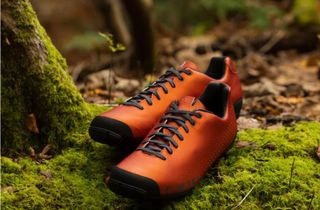
Giro Empire VR90
Specifications
Reasons to buy
Reasons to avoid
The Giro Empire VR90 combines old-school aesthetics with cutting-edge technology to deliver performance, comfort and efficiency. While these are marketed as MTB cycling shoes, we think these excellent shoes for cyclocross and gravel cycling too.
Starting with the tech, the one-piece microfibre upper comes with a rubber toe cap for extra protection and a full lace retention system. In testing, we did find these laces made it hard to get the perfect retention on the first attempt and you might find an element of mid-ride faff.
The sole uses a sticky Vibram rubber tread with an Easton EC90 full carbon sole unit. This provides the Empire with an incredibly stiff pedalling platform and ample grip in most conditions too. For those conditions and races when you might slip and slide, Giro provides steel toe spikes for extra grip.
It's worth noting that we generally find that Giro shoes come up slightly narrower than some other manufacturers, and as such the fit around the whole foot is a little tighter, so it might be worth going up a size if you have wider feet.
The VR90s weigh in at 345g for a size 45 and are available in four colours across men's and women's range and in sizes 36 to 48EU.
Read our full Giro Empire VR90 gravel bike shoe review
Best for range of sizes

Lake MX 238 Supercross
Specifications
Reasons to buy
Reasons to avoid
The Lake MX 238 provide excellent power transfer and—crucially—pliability for normal running gait when off the bike.
Right out of the box, the real leather stood out to us straight away—it felt incredibly soft to the touch. The pliability of the shoe's outer is noticeable too but a quick look inside reveals mesh inserts that make these much more robust and versatile shoes than an initial glance would suggest.
The leather may be soft but these are definitely race shoes. They have a stiff carbon sole and are water resistant, with rubber sections for added assistance when you need to run or walk. We particularly enjoyed the dual side-mounted BOA lacing system that offers next-level adjustability as seen on other premium shoes such as Shimano S-Phyre XC9 shoes.
Since the MX 238 is a race shoe, they are designed to be worn when you're working hard. In testing, we found them perfect for racing cyclocross at maximum effort but on slower-paced gravel rides our feet got a little chilly in cold weather.
The size range is huge, with wide options to suit those with wider feet.
Read our full Lake MX 238 Supercross shoe review
Best for warmer climates

Fizik Vento Ferox Carbon
Specifications
Reasons to buy
Reasons to avoid
The Fizik Vento are fantastically stiff off-road shoes that are simultaneously lightweight and breathable. These shoes will cover you for everything from cyclocross races to all-day gravel events.
Similar to the Lake MX238, the Vento uses a BOA system for optimal adjustability and comfort. This is combined with a velcro 'Powerstrap' higher up the foot for extra security. In testing, we did find it was difficult to difficult to get the tension exactly spot-on. Often it would be a little too loose or a little too tight. Most shoes at this price point use two Boa dials rather than Velcro straps, and that allows for much more fine-tuned adjustment.
Competing in the GritFest enduro gravel race, our reviewer was very impressed by the shoe’s efficiency on the climbs. The shoes' stiff soles proved to be highly durable, with the polyurethane-laminated upper shrugging off scrapes and knocks.
The Fizik Vento Ferox are significantly more expensive offering then others in this guide - but if you’re not one for mid-ride adjustments, then this is a robust performance-oriented option which could work well for you if you’re willing to pay the premium.
Read our full Fizik Vento Ferox Carbon gravel shoe review
Best for Racing

Specifications
Reasons to buy
Reasons to avoid
The Shimano RX8R is a "rally edition" of the standard Shimano RX8 shoe, which we've also put through the wringer.
The RX8R features a knitted ankle cuff to keep debris out of the shoe. It's significantly lighter than those in Shimano's MTB range such as the GR5 and the S-PHYRE. It also
has a narrower carbon sole and no toe studs. There's the same tread pattern as the standard RX8 that's not as aggressive or bulky as a full-on MTB base. Unfortunately, like other Shimano shoes, the treads are not replaceable.
We found it a struggle to get the shoes on through the quite stiff cuff, which we reckon could do with being a little taller as well. The cuff adds some warmth though - good for cooler, wet rides, less so in the summer. We also found that the single dial closure resulted in pressure over the top of the foot which could become uncomfortable.
There's a good range of sizes and half sizes on offer as well as wide-fit shoes, although no women's version yet and no sizes below 38.
Read our full Shimano RX8R gravel bike shoe review
How we test
Reviewing Shoes is somewhat subjective and some of the most demanding testing the Cycling Weekly tech team tackles. Cycling shoes are like the best bike saddles, where your autonomy heavily influences your decisions.
To offer neutral and transparent reviews our testers will outline what kind of feet they have and how the shoe worked for their specific anatomical needs. For example, do they have wide or narrow feet, was an insole required for arch support or bike fit? Where possible reference back to what shoes they normally use or have found suited them previously.
Because of this, the Cycling Weekly testers focus more on overall performance. Depending on the season and the length of the test period, we are scrutinising the materials used and their ability to resist weather and overall durability, which requires serious miles in poor conditions. Fastening and security always play a big part in the overall comfort of a shoe and some of this can be due to autonomy, so if possible we will get multiple riders to try on the shoes.
For Gravel and Cyclocross shoes, we are testing grip when walking or running off-road and the shoe's ability to clear mud. This occasionally means purposefully adding a boggy horse-trodden track to the route.
FAQs on Gravel & Cyclocross Shoes
Do I need Gravel or CX specific cycling shoes?
The short answer is probably No! For some time now both Gravel and Cyclocross riders have managed just fine using Cross-Country Mountain Bike shoes. So, whats changed?
The most noticeable changes are in the stiffness and flexibility of Gravel or CX shoes vs their racier XC counterparts. While XC shoes are durable and can withstand the rigours of mountain biking like Road shoes they are designed for performance. The capable nature of MTBs means riders very rarely need to dismount their bikes, making power transfer and efficiency far higher up the specification requirements.
Modern MTB trail centres and XC courses also feature more 'purpose-built' trails, with drainage and durable surfaces. This means there is less need for high levels of mud clearance and additional protection from the elements.
What are the different gravel shoe fastening systems?
There are basically four different systems used to tighten cycling shoes: Velcro, ratchets, laces, and dials.
Many shoes at the lower end of the price range will use Velcro straps for fastening, as it's a cheaper production method. While this is great to get you started, you will find that the longevity of the shoe can be shortened due to the mechanics of the hook and eye system getting clogged with mud and then failing to function. That said, it is a lightweight option, so even some of the top-end shoes will use the odd Velcro strap, generally at the less adjusted toe box area. Just be aware that all Velcro straps will require an element of housekeeping to ensure they remain fully functioning, especially after very wet and muddy rides.
The next step up in the fastening system food chain comes in the form of laces. Laces are great at providing lots of fit adjustability and help keep the shoe weight down, but are close to impossible to adjust on the move, and trying to un-tie wet and muddy laces post-ride with cold, wet hands will soon become one of your most hated things. You'll also find laces on some expensive gravel bike shoes like those from Rapha and Giro, as the lace closure complements a lightweight shoe construction and can distribute pressure well.
Ratchets, on the other hand, offer a good level of adjustability, security and are reasonably resistant to mud, although there can be the odd panic moment when they become clogged and fail to open, meaning a contortionist style cleaning requirement whilst still wearing them. They are super easy to adjust on the bike, although this also makes them more vulnerable in crashes and they're fairly easy to loosen by accident when you brush against trailside obstacles. Ratchet systems can be heavy, and after the sole, will be one of the factors in accounting for the weight of the shoe.
At the top end of the cycling shoe closure systems are dials. The cable and mini-barrel winch system provides very secure retention, easy micro-adjustment for a precise fit, a profile that minimises the risk of damage in a crash and all at an impressively low weight. Dials are hard to beat, however, in the famous words of Mr Keith Bontrager "strong, light, cheap - pick two". Owing to the more complex construction methods to enable dials to be used, shoes tend to be on the more expensive side.
What are the different sole materials used for gravel & CX shoes?
As with the fastening systems, there are various different materials and methods used for sole construction for cycling shoes, and the choice will largely come down to style of riding and price.
While one of the biggest choice factors in road shoes will be out-and-out stiffness, off-road shoe choice is a more 'horses for courses' approach - much like bike tyres.
Like tyres, depth and pattern of the sole ideally need to match the sort of riding/hiking/running terrain. The chunkier tread will perform best in wet mud and slippery conditions, while a thinly spaced out tread pattern is better on rocky land, and saves you from having to get a friend to act as your farrier to remove wedged chunks of stone from the sole of your shoe.
Don't be too hasty to write sole stiffness off for the mud market; many of the top-end performance cyclocross shoes will err more towards pedal power than mud or sand running prowess. If you want a more run-friendly balance, opting for a stiff midsole with a slight flex in the toe box would be a good compromise, as would the ability to swap out studs for spikes for when the course gets very muddy.
Stiffer soles are also a good option if you intend to ride more rocky routes, as, a bit like walking boots, you'll want support from the sole when off the bike and walking over uneven terrain.
At the more casual riding and touring end of the spectrum, the focus will be more on comfort on and off the bike. The shoes will still prove stiff enough for efficient pedalling, but allow sufficient flex for walking the trails as well as riding them.
Entry-level cycling shoes will generally come with nylon plastic soles, but if you pay a bit more you will get shoes with carbon composite soles (i.e. a mixture of carbon and plastic), which will help to bring the weight down a little.
For those seeking performance-specific options, then carbon-soled shoes will be the ones to look out for, as these will be stiff and light, but with that comes a risk of discomfort over longer periods on the bike and of course, the wincing as you scrabble about on anything rock or gravel like when off the bike and the underside of your shoe gets scratched and gouged.
If your gravel riding potentially contains an element of hike-a-bike, you may find that a softer compound rubber sole might be more up your (dirt) street for overall grip and durability.
What cleat systems do Gravel and Cyclocross shoes use?
All off-road clipless pedals come with cleats that use a two-bolt mounting system. There are plenty of different brands that offer pedals but on the whole, many use a Shimano SPD style cleat. Some other brands such as Time and Crankbrothers use a slightly different cleat but still with a two-bolt mount. The correct cleats should be provided with the pedals when you buy them.
What two-bolt pedal system you run shouldn't impact which shoes you choose, but you do need to ensure that the shoe offers enough adjustment that you can get the cleat in the right position for you.
Most shoes will offer an element of fore and aft adjustment, and your cleat should allow for side to side, but if you like to ride with a less common angle or position, double check the adjustability is there and that the tread pattern doesn't interfere.
What to look for in gravel and cyclocross cycling shoes
Heat moulding of cycling shoes
There are a number of different shoes and insoles on the market, such as the Bont Vaypor G and the Lake MX range that can be customised through heat moulding to fit the shape of your feet. This means that the shoes should perfectly support the arch of your foot, giving an almost bespoke fit. This is a major plus point if you do have an above-average foot support requirement. Heat mouldable shoes can provide enhanced comfort to all foot shapes, as well as help with power transfer from a performance aspect.
What conditions will you be riding in most?
In an ideal world, we'd have a different pair of shoes for every discipline of cycling and variety of riding and weather conditions. In reality, we probably have to stick to thinking about what an average ride looks like for us.
While a pair of road shoes can be beefed up in cold and wet conditions with the addition of pulling on a waterproof or neoprene overshoe, this isn't quite as practical off-road. Although there are options out there, from experience they don't survive longer than a single season, maximum.
If cold and wet weather is a constant with your gravel riding, then you might want to look for waterproof features or winter cycling boots, or if you suffer from cold feet go up a size to ensure a thermal sock and insole will fit.
With cyclocross racing being a winter sport in Europe, bad weather is almost a given, but as the duration of time and pace spent riding is shorter and higher, cross shoes are purely performance-focused. As with XC-specific shoes, as well as not being designed for spending much time off the bike, like any performance shoe, they will offer foot ventilation, so don't just assume that because it's got grip it's going to be suited to bad weather.
Try before you buy
The best way to check the fit of a shoe is to try it on in your local bike shop before purchasing (hopefully you’ll make the purchase in the shop too). It is better to do this in the afternoon or evening as your feet may expand slightly during the day.
Shoe sizing can be pretty inconsistent across brands, particularly when compared to other pieces of cycling clothing – just because your old and worn-out size 46 shoes were comfortable, it doesn’t necessarily mean you can jump straight into a different brand in the same size.
Arch heights, shoe widths and different fastening systems can all mean that you may find yourself going a size up or down when buying new cycling shoes.
As well as the custom fit that the above-mentioned heat moulding allows, some brands offer women's-specific or wide options that will help you get the best fit for your foot.
Get The Leadout Newsletter
The latest race content, interviews, features, reviews and expert buying guides, direct to your inbox!
Hannah is Cycling Weekly’s longest-serving tech writer, having started with the magazine back in 2011. She has covered all things technical for both print and digital over multiple seasons representing CW at spring Classics, and Grand Tours and all races in between.
Hannah was a successful road and track racer herself, competing in UCI races all over Europe as well as in China, Pakistan and New Zealand.
For fun, she's ridden LEJOG unaided, a lap of Majorca in a day, won a 24-hour mountain bike race and tackled famous mountain passes in the French Alps, Pyrenees, Dolomites and Himalayas.
She lives just outside the Peak District National Park near Manchester UK with her partner, daughter and a small but beautifully formed bike collection.
- Sonny EvansWriter
-
 Tweets of the year: The 20 best and most surreal social media posts of 2024
Tweets of the year: The 20 best and most surreal social media posts of 2024Wout van Aert's squirrel costume, Demi Vollering's ominous croc challenge, and Tom Pidcock's face in cake form are among the best content of the year
By Tom Davidson Published
-
 'He’s at the age now where he's coming into his prime' - Where does Tadej Pogačar go next after a year of unequalled domination?
'He’s at the age now where he's coming into his prime' - Where does Tadej Pogačar go next after a year of unequalled domination?Becoming the first male rider since 1987 to complete cycling’s hallowed triple crown earns the Slovenian this year’s prize. Tom Thewlis salutes a spectacular year
By Tom Thewlis Published
-
 Best gravel bikes 2024: our pick of the top models
Best gravel bikes 2024: our pick of the top modelsThe best gravel bikes to suit all styles, terrain and budgets from bikepacking to gravel racing
By Matt Ischt-Barnard Last updated
-
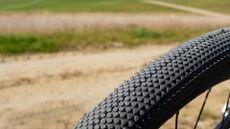 Best gravel bike tyres 2024 for extra grip, volume and speed
Best gravel bike tyres 2024 for extra grip, volume and speedWhen it comes to gravel bike riding, tyres are all important. Here's our pick of the best gravel tyres on the market to suit different terrain, conditions, frame clearances and budgets.
By Katherine Moore Last updated
-
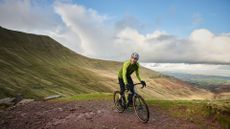 Best budget gravel bikes 2024: get off the beaten track without spending the earth
Best budget gravel bikes 2024: get off the beaten track without spending the earthThese budget gravel bikes allow you to enjoy off-road trails and explore new places without breaking the bank
By Katherine Moore Last updated
-
 Best handlebars for gravel bikes 2024: flared bars for off-road riding
Best handlebars for gravel bikes 2024: flared bars for off-road ridingThe best handlebars for gravel riding might look similar to road handlebars, but there are some subtle differences that will help elevate your gravel riding. Here are some of the best options.
By Katherine Moore Last updated
-
 Best electric gravel bikes 2024: dirt loving drop bar e-bikes with added oomph
Best electric gravel bikes 2024: dirt loving drop bar e-bikes with added oomphCould electric gravel bikes be the best and most versatile e-bikes on the market?
By Katherine Moore Last updated
-
 Best gravel bike wheels 2024: options for your gravel or adventure bike
Best gravel bike wheels 2024: options for your gravel or adventure bikeWhat are the best wheels for your gravel or adventure bike? We round up the best options for you.
By Katherine Moore Published
-
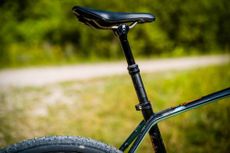 Gravel bike upgrades: the best improvements for your gravel bike
Gravel bike upgrades: the best improvements for your gravel bikeFrom quick and easy wins to significant component changes, here's our pick of the best gravel bike upgrades you can make
By Katherine Moore Last updated